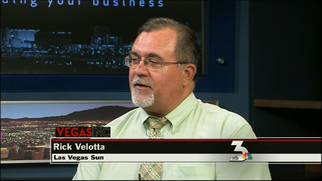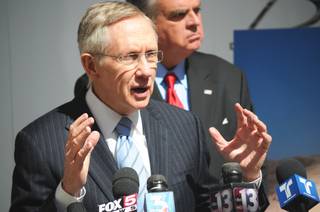VEGAS INC Archives
VEGAS INC: Rick Velotta discusses DesertXpress

Viewing video requires the latest version of Adobe's Flash Player
VEGAS INC reporter Rick Velotta discusses plans and funding for DesertXpress, the high-speed rail that will connect Southern California and Southern Nevada
High-speed rail has become the new “bridge to nowhere” in the eyes of taxpayers and it’s up to elected officials at the local level to explain to the public that big capital investments are critical for long-term prosperity nationally and locally, panelists at a rail conference concluded Friday.
A panel of three elected officials and the general manager of the Regional Transportation Commission of Southern Nevada said opponents of a national high-speed rail network are making many of the same arguments that were made in opposition to the construction of the United States’ interstate highway system in the 1950s.
“People did not see the need for an upgraded highway system back then,” said Mesa, Ariz., Mayor Scott Smith, who moderated a panel at the close of the three-day Western High-Speed Rail Alliance conference at Bellagio. “Today, nobody says the interstate highway system was a bad investment.”
Smith said when opponents questioned the need for the highways or complained about the cost, the project was then characterized as essential to national defense, which is how the system got built.
About 150 transportation experts and rail company representatives and equipment suppliers attended the event, which had its organizational roots in Las Vegas.
The Regional Transportation Commission of Southern Nevada and Las Vegas-based transportation consultant Tom Skancke recruited transportation experts from Nevada, Arizona, Utah and Colorado to form the alliance and staged its first conference last year. The organization hopes to influence national rail policy with broad representation from western states.
Utah State Sen. Ben McAdams said at first, it was a challenge to convince residents of the Salt Lake City area that they needed a light-rail system in place before the 2002 Winter Olympic Games. But once a system was in place, the next controversy was where the next extension of the line would be built.
Today, $2.8 billion has been invested in the Utah Transit Authority Trax system, which is about 80 percent complete, and there are three lines that crisscross the city from Sandy to West Valley City. The success of the light-rail system has McAdams enthused that residents could be convinced that the alliance’s interstate high-speed rail system would be an economic benefit to the area. He’s convinced that there would be plenty of demand for transportation between Salt Lake City and Las Vegas.
McAdams said Delta Air Lines is Salt Lake City’s most important air carrier, offering nonstop flights from Tokyo. He said many of Delta’s Tokyo passengers fly there, then connect on flights to Las Vegas.
Jacob Snow, general manager of the Regional Transportation Commission and a former planner at McCarran International Airport, noted that most used aircraft at McCarran is the Boeing 737, which carries between 120 and 150 passengers.
Snow said flying 737s isn’t the most efficient use of McCarran’s air space — and they aren’t the most energy-efficient way to travel. Snow said a Brookings Institution report says the energy used to lift one jet out of McCarran is the equivalent of the amount needed to run a high-speed train the entire distance between Los Angeles and Las Vegas.
Snow said there are high hopes for high-speed rail between Las Vegas and Southern California with the progress made by DesertXpress Enterprises and its proposed 185-mile line to Victorville, Calif.
But he also pointed out that DesertXpress officials had hoped to move passengers to resorts on the Las Vegas Monorail, which is operating under bankruptcy protection.
“DesertXpress’ whole plan was to connect to the Las Vegas Monorail,” Snow said. “The plan is still to connect to the monorail, but that’s looking grim now.”
But the RTC has an extensive bus network “even though bus is a four-letter word in our lexicon,” Snow said.
The agency’s Deuce route on the Strip is profitable and express buses that bring people from outlying areas to the resort corridor are growing in popularity, he said. Next up for the RTC will be consideration of a light-rail system and he said the Regional Rapid Transit Authority Advisory Committee has its first meeting next week.
Mesa’s Smith said one of the big problems with changing perceptions on high-speed rail is that those projects are legacy investments, but most elected officials are only worried about the next election cycle.
Lakewood, Colo. City Councilman Ed Peterson, a member of the Denver Regional Council of Governments, said it’s difficult to get constituents to support expensive projects like high-speed rail when most individuals are worried about the potholes in their neighborhoods.
“Finding champions is critical,” Peterson said. “A lot of politicians are worried that they won’t benefit from spending large sums of money – but their children will. We need to keep the pressure up and change people’s minds one person at a time.”

